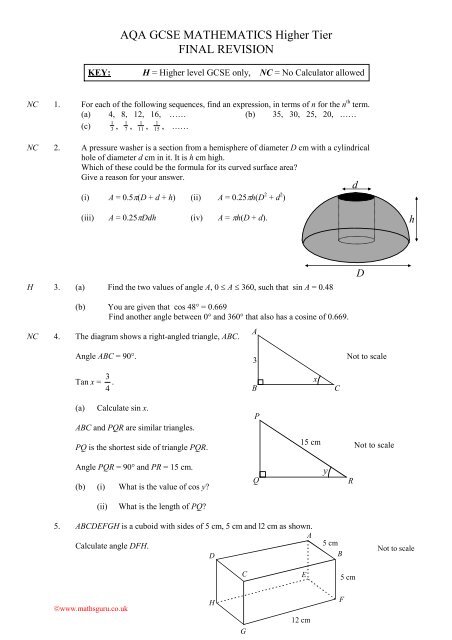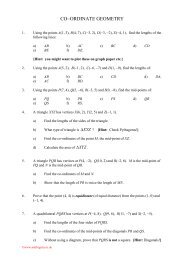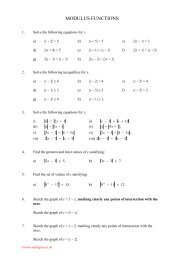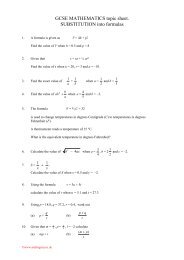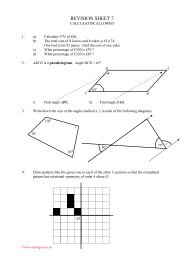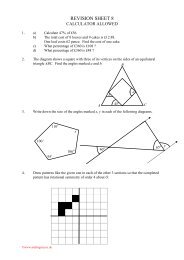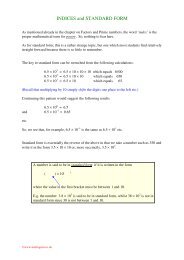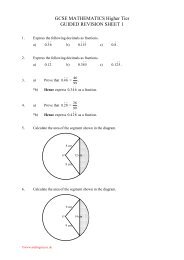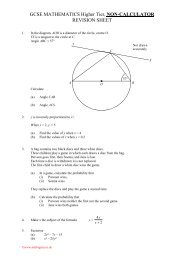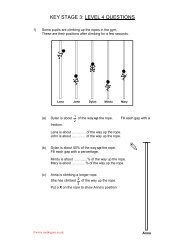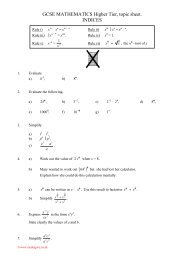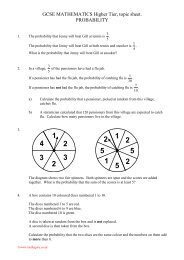AQA GCSE MATHEMATICS Higher Tier FINAL REVISION
AQA GCSE MATHEMATICS Higher Tier FINAL REVISION
AQA GCSE MATHEMATICS Higher Tier FINAL REVISION
Create successful ePaper yourself
Turn your PDF publications into a flip-book with our unique Google optimized e-Paper software.
<strong>AQA</strong> <strong>GCSE</strong> <strong>MATHEMATICS</strong> <strong>Higher</strong> <strong>Tier</strong><br />
<strong>FINAL</strong> <strong>REVISION</strong><br />
KEY:<br />
H = <strong>Higher</strong> level <strong>GCSE</strong> only, NC = No Calculator allowed<br />
NC 1. For each of the following sequences, find an expression, in terms of n for the n th term.<br />
(a) 4, 8, 12, 16, …… (b) 35, 30, 25, 20, ……<br />
1 1<br />
(c) , , , , ……<br />
1<br />
3<br />
7<br />
11<br />
1<br />
15<br />
NC 2. A pressure washer is a section from a hemisphere of diameter D cm with a cylindrical<br />
hole of diameter d cm in it. It is h cm high.<br />
Which of these could be the formula for its curved surface area?<br />
Give a reason for your answer.<br />
(i) A = 0.5(D + d + h) (ii) A = 0.25h(D 2 + d 2 )<br />
d<br />
(iii) A = 0.25Ddh (iv) A = h(D + d).<br />
h<br />
H 3. (a) Find the two values of angle A, 0 A 360, such that sin A = 0.48<br />
D<br />
(b) You are given that cos 48° = 0.669<br />
Find another angle between 0° and 360° that also has a cosine of 0.669.<br />
NC 4. The diagram shows a right-angled triangle, ABC.<br />
A<br />
Angle ABC = 90°.<br />
3<br />
Not to scale<br />
Tan x = 4<br />
3 .<br />
B<br />
x<br />
C<br />
(a) Calculate sin x.<br />
ABC and PQR are similar triangles.<br />
P<br />
PQ is the shortest side of triangle PQR.<br />
15 cm<br />
Not to scale<br />
Angle PQR = 90° and PR = 15 cm.<br />
(b) (i) What is the value of cos y?<br />
Q<br />
y<br />
R<br />
(ii)<br />
What is the length of PQ?<br />
5. ABCDEFGH is a cuboid with sides of 5 cm, 5 cm and l2 cm as shown.<br />
A<br />
Calculate angle DFH.<br />
D<br />
5 cm<br />
B<br />
Not to scale<br />
C<br />
E<br />
5 cm<br />
www.mathsguru.co.uk<br />
H<br />
G<br />
12 cm<br />
F
H 6. In triangle ABC, AB = 5 cm, BC = 8 cm and AC = 9 cm.<br />
A<br />
5 cm 9 cm<br />
not drawn accurately<br />
B<br />
8 cm<br />
C<br />
Use the cosine rule to show that triangle ABC does not contain an obtuse angle.<br />
H 7. A, B and C are three points which lie in a straight line on horizontal ground.<br />
BT is a vertical tower.<br />
T<br />
A 21.5° 13.3°<br />
C<br />
B<br />
1200 m<br />
The angle of elevation of T from A is 21.5°. The angle of elevation of T from C is 13.3°.<br />
AC = 1200 m.<br />
Calculate the height of the tower.<br />
H 8. A thin-walled glass paperweight consists of a hollow cylinder with a hollow cone on top<br />
as shown.<br />
The paperweight contains just enough sand to fill the cylinder.<br />
2 cm<br />
4 cm<br />
6 cm<br />
The paperweight is now turned upside down.<br />
x<br />
Calculate the depth of the sand, (marked x in the diagram).<br />
www.mathsguru.co.uk
9. The diagram shows two similar triangles.<br />
B<br />
6 cm<br />
A<br />
36.9°<br />
C<br />
D<br />
BC = 6 cm and angle BCA = 36.9°.<br />
Not drawn accurately<br />
E<br />
(a)<br />
Calculate the length of side AB.<br />
(b) The ratio of BC : CE is 5 : 2.<br />
Calculate the length of side DE.<br />
H 10. AB is an arc of a circle, centre O,with radius 9.7cm.<br />
Angle AOB = 110°.<br />
O<br />
110° 9.7 cm<br />
not drawn accurately<br />
Calculate the area of the sector OAB.<br />
A<br />
B<br />
H 11. ABCD is a rhombus with side length 10 cm.<br />
Angle BAD = 60°.<br />
10 cm<br />
B<br />
ABD is a sector of a circle with centre A.<br />
CBD is a sector of a circle with centre C.<br />
A<br />
60°<br />
C<br />
(a)<br />
Calculate the area of triangle ABD.<br />
(b)<br />
H-NC 12. (a) Work out<br />
Calculate the shaded area.<br />
3 1<br />
– 14<br />
2 7<br />
D<br />
(b)<br />
(c)<br />
Find an approximate value of<br />
289 × 4.13<br />
0.19<br />
You must show all your working.<br />
1 × 9<br />
Find the value of<br />
3<br />
1 2<br />
× (2)<br />
8<br />
(d) Calculate<br />
3<br />
4<br />
3<br />
5<br />
leaving your answer in the form 3 p<br />
–<br />
5<br />
(e) Work out the value of 64<br />
6<br />
Leave your answer as a fraction.<br />
www.mathsguru.co.uk
H-NC 13. (a) Work out 3.2 × 10 5 – 2.89 × 10 4<br />
(b) Work out<br />
1 2<br />
3 – 1<br />
4 5<br />
(c)<br />
2<br />
3<br />
Find the value of 8<br />
(d)<br />
3<br />
7<br />
Express 128 as a fraction.<br />
(e) Express<br />
8<br />
3<br />
4<br />
3<br />
in the form 3 p<br />
14. The number of people waiting for an island ferry is 25% over the legal safety limit.<br />
What percentage of the people waiting must the ferry leave behind so that it departs with<br />
the maximum number of passengers allowed?<br />
15. A shopkeeper normally sells his goods at 70% above cost price.<br />
In a sale he reduces his prices by 40%.<br />
What percentage profit does the shopkeeper make on goods sold in the sale?<br />
NC 16. Brass is made from the metals copper, zinc and tin in the ratio 7 : 3 : 2<br />
How much copper is needed to make 60 kg of brass?<br />
17. Use trial and improvement to find a solution to the equation<br />
x 3 + 2x = 60.<br />
Give your answer correct to 1 decimal place.<br />
12 .3(18.5 + 9.41)<br />
18. (a) Find the greatest possible value of<br />
15.8<br />
All the numbers are given correct to three significant figures.<br />
Write down your full calculator display.<br />
(b)<br />
A trailer can safely carry weights up to 5200 kg, correct to two significant figures.<br />
It is loaded with boxes weighing 115 kg, correct to the nearest kilogram.<br />
Calculate the greatest number of boxes that the trailer can carry safely.<br />
You must show all your working.<br />
NC 19. (a) Expand and simplify<br />
(x + 4) 2<br />
H (b) The diagram shows the circle x 2 + y 2 = 36 and the line y = x + 4.<br />
The line and the circle intersect at the points A and B.<br />
y<br />
y<br />
= x + 4<br />
B<br />
Not drawn accurately<br />
A<br />
O<br />
x<br />
x<br />
+ y = 36<br />
2 2<br />
www.mathsguru.co.uk<br />
Show that the x-coordinates of A and B are given by the solutions to the equation<br />
x 2 + 4x – 10 = 0
H (c) Solve the equation x 2 + 4x – 10 = 0.<br />
Give your answers to 2 decimal places.<br />
You must show your working.<br />
NC 20. (a) Factorise completely 12y 2 – 8y<br />
(b)<br />
n is an integer.<br />
List the values of n such that –6 3n < 13<br />
(c) Simplify (2xy 2 ) 3<br />
H-NC 21.<br />
The graph of y = 7 + 5x 2x 2 is sketched below.<br />
y C<br />
not drawn accurately<br />
A<br />
B<br />
x<br />
(a)<br />
(b)<br />
Find the coordinates of the points A and B, where the curve crosses the x-axis.<br />
C is the point on the curve where the value of y is a maximum.<br />
Use your answer to (a) to find the value of x at C.<br />
22. Make r the subject of the formula<br />
r – 3 = (t – 2r)<br />
5 + x<br />
23. You are given the formula y =<br />
x<br />
Rearrange the formula to give x in terms of y.<br />
x 2<br />
24. Solve the equation – = 1<br />
x + 1 x – 1<br />
H 25. Simplify<br />
2<br />
5x + 14x<br />
– 3<br />
x<br />
2<br />
– 9<br />
H 26. You are given that x 2 – 6x + 13 = (x – a) 2 + b<br />
(a) Find the values of a and b.<br />
(b) Hence find the minimum value of x 2 – 6x + 13.<br />
H 27. (a) Complete the table of values for y = x 2 – 4x – 2<br />
x –2 –1 0 1 2 3 4 5 6<br />
y 10 3 –2 –5 –5 –2 3 10<br />
(b) On graph paper, draw the graph y = x 2 – 4x – 2 for values of x between –2 and 6.<br />
(c) Use your graph to write down the solutions of the equation x 2 – 4x – 2 = 0<br />
(d)<br />
By drawing a straight line, the equation of which must be stated, find approximate<br />
solutions of the equation x 2 – 5x –3 = 0<br />
www.mathsguru.co.uk
28. In the diagram, the lines AC and BD intersect at E.<br />
AB and DC are parallel and AB = DC.<br />
A<br />
B<br />
E<br />
D<br />
C<br />
Prove that triangles ABE and CDE are congruent.<br />
H 29. (a) Factorise 2x 2 – 7x – 15<br />
(b) The graph of y = 2x 2 – 7x – 15 is sketched below.<br />
y<br />
Not to scale<br />
P<br />
Q<br />
x<br />
Find the equation of the line of symmetry of this graph.<br />
H 30. (a) The graph y = x 2 is transformed as shown.<br />
y<br />
y<br />
y = x<br />
2<br />
Not drawn<br />
accurately<br />
O<br />
x<br />
(–3,0)<br />
O<br />
x<br />
(b)<br />
Write down the equation of the transformed graph.<br />
The graph of y = 3x – 2 is sketched below.<br />
y<br />
On the same axes, sketch the graph of<br />
y = 2 – 3x<br />
O<br />
x<br />
www.mathsguru.co.uk
H 31. The diagram shows two sets of parallel lines.<br />
Vector PQ = a and vector PS = b<br />
PR =<br />
3PQ<br />
and PU = 2PS<br />
U V W<br />
S<br />
b<br />
P a Q R<br />
(a) Write the vector PV in terms of a and b.<br />
T<br />
Not to scale<br />
(b)<br />
Write the vector RU in terms of a and b<br />
(c) Find two vectors that can be written as 3a – b<br />
H 32. PQRSTU is a regular hexagon and O is the centre of the hexagon.<br />
OP = p and OQ = q<br />
U<br />
p<br />
P<br />
Express each of the following vectors in terms of p and q<br />
T<br />
O<br />
q<br />
Q<br />
(a)<br />
PQ<br />
(b)<br />
SP<br />
S<br />
R<br />
(c)<br />
SQ<br />
H 33. The base of a triangle is 7 cm longer than its height.<br />
The area of the triangle is 32 cm 2 .<br />
(a)<br />
(b)<br />
Taking the height to be h cm, show that<br />
h 2 + 7h 64 = 0<br />
Solve this equation to find the height of the triangle.<br />
Give your answer to 2 decimal places.<br />
34. (a) Make x the subject of x 2 + k = 16.<br />
(b) Make P the subject of<br />
PRT<br />
A = P +<br />
100<br />
35. (a) In the diagram, O is the centre of the circle.<br />
Not drawn accurately<br />
a<br />
O<br />
62°<br />
Calculate the value of a.<br />
www.mathsguru.co.uk
(b) In the diagram below, O is the centre of the circle and angle PSR = 100°.<br />
Q<br />
Not drawn accurately<br />
P<br />
O<br />
b<br />
100°<br />
S<br />
R<br />
Calculate the value of b.<br />
H (c) CD is a tangent to the circle at C.<br />
A<br />
Not drawn accurately<br />
c<br />
B<br />
50°<br />
44°<br />
C<br />
D<br />
Calculate the value of c. Give reasons for your answer.<br />
36. (a) O is the centre of the circle.<br />
p<br />
O<br />
q<br />
110°<br />
not drawn accurately<br />
(i)<br />
(ii)<br />
Calculate the value of angle p. Give a reason for your answer.<br />
Calculate the value of angle q. Give a reason for your answer.<br />
H (b) UPT is a tangent to the circle.<br />
QRS is a straight line.<br />
S<br />
R<br />
Q<br />
not drawn accurately<br />
U P T<br />
Prove that angle PRS = angle QPT.<br />
www.mathsguru.co.uk
37. The diagram shows part of a regular polygon.<br />
Each interior angle is 162°.<br />
Not drawn accurately<br />
162°<br />
Calculate the number of sides of the polygon.<br />
H-NC 38.<br />
Simplify fully<br />
(a) 8 × 8 0 × 8 –1<br />
(b)<br />
1<br />
5 –2 × (5 3 ) 3<br />
(c) 15 2 1<br />
× 3 2 1<br />
× 5 2 1<br />
H-NC 39. (a) By rationalising the denominator, simplify<br />
2<br />
=<br />
(b) Show that ( 3 + 12 ) 27<br />
15<br />
5<br />
H-NC 40. (a) Write 600 + 54 in the form p 6 where p is an integer.<br />
(b)<br />
600 + 54<br />
Hence write<br />
in the form q .<br />
338<br />
You may use 338 = 2 × 13 2<br />
NC 41. Salt is sold in different sized blocks.<br />
The weight of each block, B kilograms, is directly proportional to the cube of its<br />
height, h metres.<br />
A block of weight 54 kg has height 3m.<br />
(a) Find an equation connecting h and B.<br />
(b) Find the weight of a block with a height of 1m.<br />
(c) Another block has a weight of 128 kg. Find its height.<br />
H-NC 42. (a) Work out the exact value of ( 3 ) 4<br />
(b) Write 32 in the form 2 p<br />
(c) Find the value of (0.25) –1<br />
3<br />
(d) Find the value of 81 4 Leave your answer as a fraction.<br />
H 43. Prove that the product of two odd numbers is always an odd number.<br />
H-NC 44. (a) Write 0.1<br />
8 <br />
as a fraction in its simplest form.<br />
(b) Hence or otherwise express 0.51<br />
8<br />
as a fraction.<br />
www.mathsguru.co.uk
H 45. The diagram shows the graph of y = 2x + 1.<br />
y<br />
6<br />
5<br />
4<br />
3<br />
2<br />
1<br />
–5 –4 –3 –2 –1 0 1 2 3 4 5 6 7 x<br />
–1<br />
–2<br />
–3<br />
–4<br />
–5<br />
–6<br />
A line passes through the point (2, 3) and is perpendicular to y = 2x + 1.<br />
The equation of this line can be written in the from ax + by = c.<br />
What are the values of a, b and c?<br />
46. The line l passes through the points A (0, 3) and B (–4, 11).<br />
(a) Calculate the gradient of the line l.<br />
(b) Write down the equation of the line l.<br />
H (c) Write down the equation of the line which also passes through the point (0, 3) but<br />
is perpendicular to line l.<br />
H 47. Gnomes ‘R’Us makes garden gnomes in two sizes.<br />
The gnomes are similar in shape.<br />
The smaller gnome is 28 cm high and the larger one is 35 cm high.<br />
It takes 7936 cm 3 of plaster to make a small gnome.<br />
How much plaster is needed to make a large gnome?<br />
www.mathsguru.co.uk
48. A coffee machine dispenses 130 millilitres of black coffee into cups with a capacity of<br />
175 millilitres.<br />
These values are accurate to 3 significant figures.<br />
Milk is supplied in small cartons which contain 21 millilitres, accurate to the nearest<br />
millilitre.<br />
Beryl likes milky coffee and always puts 2 cartons of milk in her coffee.<br />
Will Beryl’s cup ever overflow?<br />
You must show all your working.<br />
49. In a village<br />
5<br />
3 of the pensioners have had a flu jab.<br />
1<br />
If a pensioner has had the flu jab the probability of catching flu is<br />
30<br />
7<br />
If a pensioner has not had the flu jab the probability of catching flu is<br />
10<br />
(a)<br />
(b)<br />
Calculate the probability that a pensioner, picked at random, from this village<br />
catches flu.<br />
A statistician calculated that 120 pensioners from this village are expected to catch<br />
flu.<br />
Calculate how many pensioners live in the village.<br />
50. Shaz has ten one pound coins.<br />
Six have a thistle design and four have a leek design.<br />
She chooses a one pound coin at random.<br />
If the first coin has a thistle design she replaces it, and chooses again.<br />
If the first coin has a leek design she does not replace it, but chooses again.<br />
What is the probability that the second coin has a leek design?<br />
www.mathsguru.co.uk
51. The cumulative frequency graphs represent the lengths of 40 programmes on Channel 1<br />
and 40 programmes on Channel 3.<br />
40<br />
Channel 1<br />
30<br />
Cumulative<br />
frequency<br />
20<br />
Channel 3<br />
10<br />
(a)<br />
(b)<br />
0<br />
0 10 20 30 40 50<br />
Length (minutes)<br />
What is the difference between the median programme lengths for the two<br />
channels?<br />
How many programmes in total were more than 25 minutes long?<br />
52. The scatter graph shows the number of petrol pumps and the number of cars queuing at<br />
midday at six garages.<br />
Number<br />
of cars<br />
queuing<br />
6<br />
5<br />
4<br />
3<br />
2<br />
1<br />
×<br />
×<br />
×<br />
× ×<br />
×<br />
0<br />
0 1 2 3 4 5 6 7 8 9<br />
(a)<br />
(b)<br />
(c)<br />
Number of petrol pumps<br />
State the type of correlation shown.<br />
Use the scatter graph to estimate the number of cars queuing at a garage with<br />
8 petrol pumps.<br />
Explain why your answer in part (b) may be unreliable.<br />
www.mathsguru.co.uk
H 53. The heights of 30 children are given in the table below.<br />
Height in cm frequency<br />
150 x < 155 2<br />
155 x < 160 5<br />
160 x < 165 8<br />
165 x < 170 10<br />
170 x < 175 5<br />
(a)<br />
(b)<br />
Calculate an estimate of the mean height.<br />
Calculate an estimate of the standard deviation of the heights.<br />
H 54. The histogram shows information about how much time was spent in a supermarket by<br />
100 shoppers.<br />
2.0<br />
1.5<br />
Frequency<br />
density<br />
1.0<br />
0.5<br />
(a)<br />
0<br />
0 10 20 30 40 50 60 70 80<br />
Time, t (minutes)<br />
Complete this frequency table:<br />
Time, t (minutes) 0 < t 5 5 < t 20 20 < t 30 30 < t 60 60 < t 80<br />
Number of shoppers 6 15 25<br />
(b)<br />
20% of the shoppers are in the supermarket for more than T minutes.<br />
Calculate an estimate of the value of T.<br />
(2)<br />
www.mathsguru.co.uk


